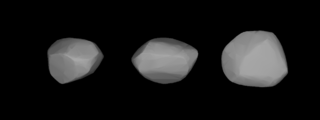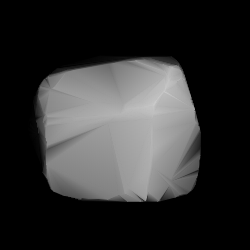Related Research Articles

86 Semele is a large and very dark main-belt asteroid with an orbital period of 5.5 years. It is rotating with a period of 16.6 hours, and varies in magnitude by 0.13 during each cycle. This object is classified as a C-type asteroid and is probably composed of carbonates.

153 Hilda is a large asteroid in the outer main belt, with a diameter of 170 km. The spectrum matches that of a P-type asteroid. It was discovered by Johann Palisa on 2 November 1875, from the Austrian Naval Observatory at Pula, now Croatia. The name was chosen by the astronomer Theodor von Oppolzer, who named it after one of his daughters. It is the largest member of the hilda family, a collisional family of asteroids in the Hilda region.

242 Kriemhild is a main belt asteroid that was discovered by Austrian astronomer Johann Palisa on 22 September 1884 in Vienna and was named after Kriemhild, a mythological Germanic princess, by Moriz von Kuffner, a Viennese industrialist and sponsor of astronomy.

261 Prymno is a somewhat large Main belt asteroid. It is classified as a B-type asteroid and probably has a primitive composition not unlike common C-type carbonaceous asteroids.

340 Eduarda is a main belt asteroid that was discovered by German astronomer Max Wolf on 25 September 1892 in Heidelberg. It was named after German banker and amateur astronomer Heinrich Eduard von Lade.
479 Caprera is a minor planet orbiting the Sun.
500 Selinur is a minor planet, specifically an asteroid orbiting in the asteroid belt. Like 501 Urhixidur and 502 Sigune, it is named after a character in Friedrich Theodor Vischer's then-bestseller satirical novel Auch Einer.
506 Marion is a minor planet orbiting the Sun. It was discovered by Raymond Smith Dugan in February 1903, and was later named after a cousin of his. It is designated as a C-type asteroid with a size of approximately 104 kilometres (64.6 mi).
514 Armida is a minor planet orbiting the Sun. According to the Catalogue of Minor Planet Names and Discovery Circumstances, it is "named for the beautiful legendary sorceress in Torquato Tasso’s (1544–1595) Jerusalem Delivered. She is the leading character in the opera Armida by Christoph Willibald Gluck (1714–1787)."
521 Brixia is a relatively large minor planet, specifically an asteroid orbiting mostly in the asteroid belt that was discovered by American astronomer Raymond Smith Dugan on January 10, 1904. The name derives from Brixia, the ancient name of the Italian city of Brescia.
524 Fidelio is a large minor planet with a diameter of 71 km, orbiting the Sun near the center of the main asteroid belt. Fidelio contains both metals and carbon. Concerning its name, the Catalogue of Minor Planet Names and Discovery Circumstances notes, "This is the name of Leonora when disguised as a man in the opera Fidelio by the German composer Ludwig van Beethoven. The name dates from a period when Max Wolf assigned the names of female operatic characters to asteroids he had newly discovered.
535 Montague is a minor planet orbiting the Sun that was discovered by Raymond Smith Dugan on 7 May 1904 in Heidelberg, Germany. It was named after the town Montague in Massachusetts.
546 Herodias is a carbonaceous asteroid from the central regions of the asteroid belt, approximately 66 kilometers in diameter. It is an identified Eunomian interloper. It was named after the biblical character Herodias.
586 Thekla is a minor planet orbiting the Sun. It was named after Saint Thecla of the first century. The name may have been inspired by the asteroid's provisional designation 1906 TC.
633 Zelima is a minor planet orbiting the Sun in the asteroid belt with a magnitude of 10.7. The name may have been inspired by the asteroid's provisional designation 1907 ZM.

643 Scheherezade is a minor planet orbiting the Sun. It was named after the fictional storyteller Sheherazad.
678 Fredegundis is a minor planet orbiting the Sun. It was discovered 22 January 1909 from Heidelberg by German astronomer K. Wilhelm Lorenz, and was named after the French opera Frédégonde. This object is orbiting at a distance of 2.57 AU with a period of 4.13 years and an eccentricity (ovalness) of 0.22. The orbital plane is inclined at an angle of 6.1° to the plane of the ecliptic
693 Zerbinetta is a minor planet orbiting the Sun. It was discovered on 21 September 1909 by August Kopff in Heidelberg and named after a character in Richard Strauss' opera Ariadne auf Naxos.
1818 Brahms, provisional designation 1939 PE, is an asteroid from the inner regions of the asteroid belt, approximately 6 kilometers in diameter. It was discovered on 15 August 1939, by German astronomer Karl Reinmuth at Heidelberg Observatory in southern Germany. The asteroid was named after composer Johannes Brahms.
2055 Dvořák, provisional designation 1974 DB, is an eccentric asteroid and sizable Mars-crosser from the innermost regions of the asteroid belt, approximately 8 kilometers in diameter. It was discovered on 19 February 1974, by Czech astronomer Luboš Kohoutek at the Bergedorf Observatory in Hamburg, Germany. It was named after Czech composer Antonín Dvořák.
References
- ↑ "549 Jessonda (1904 PK)". JPL Small-Body Database . NASA/Jet Propulsion Laboratory . Retrieved 5 May 2016.
- ↑ Accessed on line [ permanent dead link ]